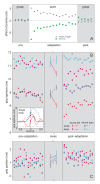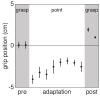Unusual prism adaptation reveals how grasping is controlled
- PMID: 28891465
- PMCID: PMC5619946
- DOI: 10.7554/eLife.21440
Unusual prism adaptation reveals how grasping is controlled
Abstract
There are three main theories on how human grasping movements are controlled. Two of them state that grip aperture and the movement of the hand are controlled. They differ in whether the wrist or the thumb of the hand is controlled. We have proposed a third theory, which states that grasping is a combination of two goal-directed single-digit movements, each directed at a specific position on the object. In this study, we test predictions based on each of the theories by examining the transfer of prism adaptation during single-digit pointing movements to grasping movements. We show that adaptation acquired during single-digit movements transfers to the hand opening when subsequently grasping objects, leaving the movement of the hand unaffected. Our results provide strong evidence for our theory that grasping with the thumb and index finger is based on a combination of two goal-directed single-digit movements.
Keywords: coordination; grasping; human; neuroscience; prehension; prism adaptation; visuomotor.
Conflict of interest statement
No competing interests declared.
Figures




References
Publication types
MeSH terms
LinkOut - more resources
Full Text Sources
Other Literature Sources

